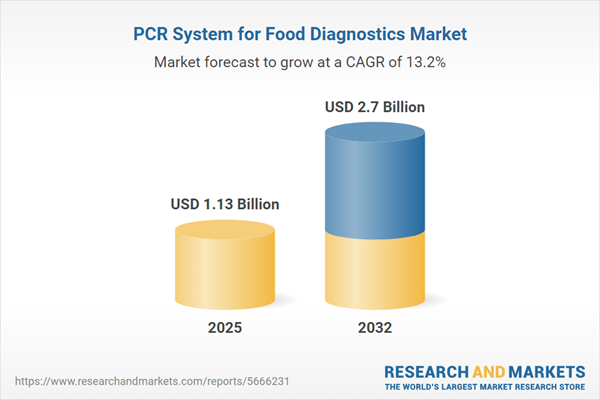Speak directly to the analyst to clarify any post sales queries you may have.
Senior decision-makers in the food diagnostics sector are navigating an era defined by rapid technological advances and increasingly rigorous food safety standards. Leveraging next-generation PCR system capabilities, organizations can strengthen food safety protocols, respond to shifting market dynamics, and future-proof their competitive position.
Market Snapshot: PCR System for Food Diagnostics Market Growth and Trends
The PCR System for Food Diagnostics Market grew from USD 1 billion in 2024 to USD 1.13 billion in 2025. It is expected to continue growing at a CAGR of 13.15%, reaching USD 2.70 billion by 2032. These figures reflect robust momentum for advanced polymerase chain reaction technologies in the food quality assurance landscape, as regulations and consumer expectations converge to accelerate adoption globally.
Scope & Segmentation
This report delivers comprehensive insight into the evolving landscape of food diagnostics via PCR systems. Detailed segmentation ensures senior leaders can pinpoint relevant opportunities:
- Product Types: Covers conventional PCR such as agarose-based and gel-based systems, digital PCR including droplet and microfluidic solutions, and real-time PCR utilizing SYBR Green and TaqMan probe chemistries.
- Applications: Encompasses allergen detection, GMO analysis, pathogen identification (bacterial, fungal, viral), and quality control including adulteration and shelf life testing.
- End Users: Addresses the needs of contract testing laboratories, food processors, regulatory bodies, and research institutions seeking tailored diagnostic workflows.
- Platforms: Includes benchtop systems for established labs and portable devices for on-site and field use.
- Component Ecosystem: Examines consumables (kits, reagents), instrument modules (detection, thermal cyclers), services (consulting, maintenance), and software (data analysis, sample management).
- Regional Coverage: Market intelligence extends across Americas (North and Latin America), Europe, Middle East and Africa, and Asia-Pacific, highlighting localized drivers and adoption patterns.
- Company Developments: Reviews notable strategies from leading manufacturers such as Thermo Fisher Scientific, Danaher Corporation, Agilent Technologies, and others influencing the PCR diagnostics landscape.
Key Takeaways for Senior Decision-Makers
- The integration of PCR systems in food diagnostics is now a fundamental requirement for safety compliance, given evolving global regulations and heightened consumer awareness.
- Adoption of digital and real-time PCR is enhancing precision and efficiency, as these systems reduce manual errors and deliver rapid, actionable insights.
- Automated, cloud-enabled platforms streamline workflows for both large-scale laboratories and smaller processors needing scalable, flexible solutions.
- Strategic collaborations between equipment manufacturers and software providers are driving the creation of full-service, end-to-end diagnostics offerings.
- Multiplex assays and portable PCR solutions are expanding operational capacity, making high-quality food safety testing accessible even in decentralized or resource-limited environments.
Tariff Impact: Navigating Regulatory and Supply Chain Shifts
The implementation of new United States tariffs in 2025 has reshaped global supply chains for PCR reagents, instruments, and consumables. To maintain cost control and continuity, manufacturers are diversifying sourcing strategies, enhancing local production efforts, and investing in reagent formulations less dependent on restricted imports. Laboratories, in response, are optimizing inventory management and increasing their reliance on dual procurement models to safeguard critical diagnostics capacity through times of tariff volatility. These shifts are driving supplier innovation while also promoting greater adaptability and resilience within end-user organizations.
Advanced Methodology & Data Sources
This report’s insights are underpinned by a rigorous research process, including extensive secondary analysis of peer-reviewed journals and industry white papers, followed by primary interviews with laboratory leaders, procurement managers, and technical experts. Findings were validated through data triangulation and industry expert review to ensure the highest levels of reliability.
Why This Report Matters
- Strategic recommendations empower enterprises to navigate complex regulatory changes and optimize investment in leading-edge PCR diagnostics solutions.
- Segmented insights facilitate targeted resource allocation and partnership formation across product, end user, and regional axes.
- Comprehensive competitive analysis supports stronger market position and helps decision-makers anticipate emerging opportunities.
Conclusion
Food diagnostics leaders can leverage this report’s holistic analysis to align innovation priorities with evolving compliance and market demands. The outlined strategies and insights foster more informed decisions and robust growth pathways in a dynamic industry environment.
Additional Product Information:
- Purchase of this report includes 1 year online access with quarterly updates.
- This report can be updated on request. Please contact our Customer Experience team using the Ask a Question widget on our website.
Table of Contents
3. Executive Summary
4. Market Overview
7. Cumulative Impact of Artificial Intelligence 2025
Companies Mentioned
The companies profiled in this PCR System for Food Diagnostics market report include:- Thermo Fisher Scientific Inc.
- Danaher Corporation
- Agilent Technologies, Inc.
- Bio-Rad Laboratories, Inc.
- QIAGEN N.V.
- F. Hoffmann-La Roche AG
- PerkinElmer, Inc.
- Merck KGaA
- Abbott Laboratories
- bioMérieux SA
Table Information
| Report Attribute | Details |
|---|---|
| No. of Pages | 182 |
| Published | October 2025 |
| Forecast Period | 2025 - 2032 |
| Estimated Market Value ( USD | $ 1.13 Billion |
| Forecasted Market Value ( USD | $ 2.7 Billion |
| Compound Annual Growth Rate | 13.1% |
| Regions Covered | Global |
| No. of Companies Mentioned | 11 |









